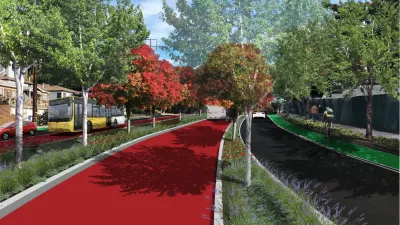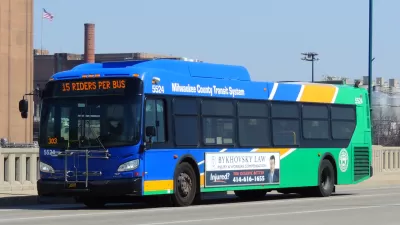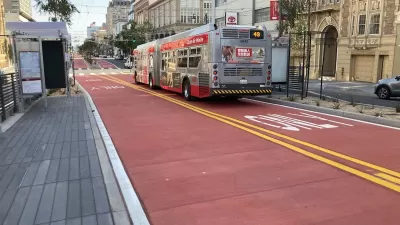In the '90s, Keanu Reeves was hurtling down the roads and freeways of L.A. in a bus; 25 years later, city officials ponder ways to bring the city’s average bus speed above 10 mph.
A lot has changed since the 1994 premiere of Speed, but the big blue buses are still operating. The premise of the movie is that a bomb planted on one of these buses is armed when the bus hits 50 mph, and will detonate if the bus drops below that speed. The plot was always far-fetched, but today, "It’s difficult to envision any vehicle, let alone a bus, reaching and sustaining 50 miles per hour at 8:30 a.m. on the 10 freeway," Elijah Chiland writes for Curbed.
In the quarter century since the film came out, average bus speed in that corridor is down about 3 mph, and costs are up. The buses that serve Santa Monica face worse traffic today than they did in the Speed-era. "As Virginia-based transit analyst Mobility Lab points out, bus riders are generally most impacted by worsening congestion, since even slight delays can create a domino effect that makes buses run behind schedule for much of the day," Chiland reports. When bus routes take longer, it means each vehicle can run the route fewer times. "Bus schedules don’t change when there’s bad traffic, so in order to ensure on-time arrivals, agencies must add more buses to a route as regional congestion worsens," Chiland writes.
The city could address the issue with a congestion pricing scheme or bus rapid transit (BRT) lanes, but neither is an easy sell politically. Though there are already some BRT lanes in the city, BRT works best where there’s already congestion, so while taking away a traffic lane can anger some drivers, asking them to pay congestion pricing can have the same effect. The other option is to let service quality on these buses continue to decline. So far that's the option the city has taken.
FULL STORY: 25 years after ‘Speed,’ can LA get its buses moving again?

Maui's Vacation Rental Debate Turns Ugly
Verbal attacks, misinformation campaigns and fistfights plague a high-stakes debate to convert thousands of vacation rentals into long-term housing.

Planetizen Federal Action Tracker
A weekly monitor of how Trump’s orders and actions are impacting planners and planning in America.

In Urban Planning, AI Prompting Could be the New Design Thinking
Creativity has long been key to great urban design. What if we see AI as our new creative partner?

King County Supportive Housing Program Offers Hope for Unhoused Residents
The county is taking a ‘Housing First’ approach that prioritizes getting people into housing, then offering wraparound supportive services.

Researchers Use AI to Get Clearer Picture of US Housing
Analysts are using artificial intelligence to supercharge their research by allowing them to comb through data faster. Though these AI tools can be error prone, they save time and housing researchers are optimistic about the future.

Making Shared Micromobility More Inclusive
Cities and shared mobility system operators can do more to include people with disabilities in planning and operations, per a new report.
Urban Design for Planners 1: Software Tools
This six-course series explores essential urban design concepts using open source software and equips planners with the tools they need to participate fully in the urban design process.
Planning for Universal Design
Learn the tools for implementing Universal Design in planning regulations.
planning NEXT
Appalachian Highlands Housing Partners
Gallatin County Department of Planning & Community Development
Mpact (founded as Rail~Volution)
City of Camden Redevelopment Agency
City of Astoria
City of Portland
City of Laramie





























